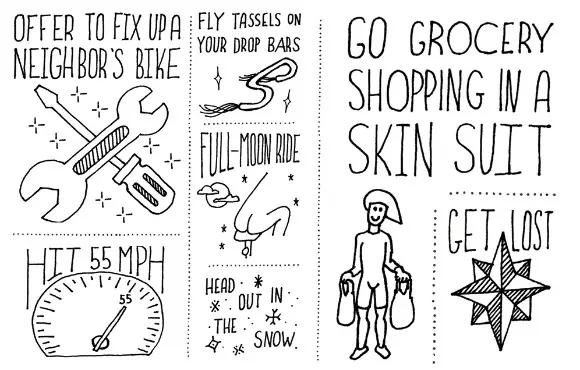Brrrrrrr!
1 of 12Cold is a relative term, but everybody eventually reaches a point where the outside air seems less-than-optimal for a bike ride.
Ranging from cool to cold, this guide will help you prepare for any cold weather conditions you may face.
Base Layer and All-Season Jersey
2 of 12
Let's get back to the basics. A lightweight base layer and a mid-weight, all-season jersey is the foundation of all cold weather kits. Perfect for layering, these two necessities keep your core warm, and ultimately help conserve energy.
The SockGuy sleeveless base layer and ROKA Pro All-Season Jersey complement each other perfectly. Pearl Izumi's long-sleeve base layer is perfect for seriously sub-zero temps.
Arm Warmers
3 of 12
If the weather is questionable, you may only need a pair of arm warmers to keep your temperature up. If the cloud cover burns off, simply remove and store them in your jersey pockets.
Remember these rules, though:
1. The logos go on the outside of your forearm.
2. The elastic band around your bicep goes UNDER your jersey's sleeve, NOT over.
Bellwether and Gore Bike Wear are our go-to brands.
Leg Warmers
4 of 12
Your legs can handle considerably colder temperatures since they're constantly working, but cold weather still permits the use of leg warmers.
Similar rules apply:
1. The zippers go on the outside of your ankle.
2. The elastic band around your quad goes UNDER the bib's hem, NOT over.
Gloves
5 of 12
Cold hands can be debilitating on a long, frigid ride.
Frozen fingers not only limit your ability to shift efficiently, they're just plain painful. Cycling-specific gloves come in different weights for wind, rain and snow, and can be complemented with liners for maximum warmth.
Be highly selective when you choose a pair and look for high-visibility touches like the ones on this pair from Liv. Ergo pads in the palms and fleecy lining on the thumbs will add comfort (you gotta wipe that snot somewhere), and some gloves have smartphone-friendly fingertips so you can use your device without getting frostbite.
Vest
6 of 12
A cycling vest is one of the more versatile pieces of cold weather gear, and it's a great, packable layer to keep your core warm. The front breaks the wind, and the back generally features a mesh construction to allow moisture to escape.
This Pearl Izumi vest is a lightweight and high-visibility option--perfect for cold, overcast conditions.
Wool Socks
7 of 12
Happy feet, happy cyclist.
Unlike running in the cold, a cyclist's feet are almost sedimentary when clipped in. The lack of blood flow makes feet more susceptible to the cold, so a thick pair of wool socks will help keep your feet warm and dry.
SockGuy has several offerings we particularly like.
Long-Sleeve Jersey and Tights
8 of 12
Truly freezing temps call for breaking out the long-sleeve jersey and tights. Remember, though, going full-sleeve and full-leg means you're committed to the additional warmth they provide.
If there's even a chance the sun might break through the clouds and warm up your day, you're usually better off going with the layered, easily removable option of arm and leg warmers. When the temperature does warrant full cold weather gear, look for a thoughtful design that incorporates elements like high-visibility accents, all-weather material, zippered ankles and jersey pockets roomy enough to slip gloved hands into.
Pearl Izumi has done a nice job of creating a highly functional but still breathable cold weather line for men and women.
Balaclava
9 of 12
Bala-what??
Multifunctional headwear was developed back in the late 19th century (it was developed to wear under chainmail, in case you're curious), and balaclavas are close-fitting garments that cover parts of your head, neck and face. Here in the U.S., you're probably more familiar with calling it a winter collar or a Buff.
The Buff, shown here, is perfect for the entire gamut of winter weather, The versatile accessory has 12 different variations you can employ to cover up in the cold, and microfiber, merino wool and UV-protective options.
Winter Cap
10 of 12
Sure, scientists long ago debunked the "we lose half of our body heat from our head" myth. But the head, face and chest are still more sensitive to changes in temperature than the rest of the body, so while covering your noggin may not actually prevent heat loss, you'll still be a happier cyclist for it.
This soft-shell Belgian cap from Swrve is water- and wind-resistant and, most importantly, covers your ears with cozy fleece. Trust us when we say you want those ears protected from the elements on a chilly ride.
Shoe Covers
11 of 12
When it comes to protecting your feet, there are endless variations on the market. We prefer an overshoe, which typically has a zippered opening in the rear to make pulling them on and off easy. Make sure you check the sole coverage before investing, though--the more you cover, the warmer you'll be.
Neoprene overshoes have the added advantage of protecting your feet from water and keeping them from freezing if dampness does slip in. On the flip side, booties are a more sock-like option--they'll keep your feet warm, but most aren't waterproof.
Lastly, toe covers are a quick, easy option for early spring or winter, when the temperatures have dropped enough to cause discomfort but not enough to warrant full coverage. Quickly slip them onto the toe box of your shoe to provide instant warmth.







Discuss This Article